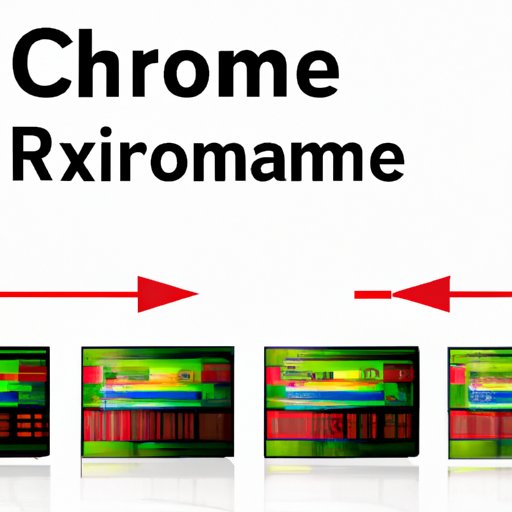Introduction
If you’ve ever used Google Chrome, you may have noticed that it seems to eat up a lot of your computer’s resources, particularly RAM. Chrome’s high RAM usage can be a problem for users with limited resources or older computers, causing slow performance, freezing, or crashing. However, the reason for Chrome’s RAM usage is not just due to poor optimization or inefficient design. In this article, we’ll explore the technical and practical reasons why Chrome uses so much RAM, how it compares to other browsers, and what you can do about it.
Chrome’s Multi-Process Architecture and its Impact on RAM Usage
One of the main reasons Chrome consumes so much RAM is its multi-process architecture. Rather than running all tabs and extensions within a single process, Chrome creates a separate process for each browser tab, and a few additional processes for extensions and plugins. This approach enables Chrome to provide better stability and security by isolating each web page and preventing malicious or buggy code from affecting other tabs or the main browser process.
However, the downside of this architecture is that it requires more memory to run multiple processes, especially as the number of tabs increases. Each process contains its own memory space, which means that the more tabs you open, the more memory Chrome uses. If you have a lot of tabs open, you may notice that Chrome takes up several gigabytes of RAM, which can slow down your computer or cause it to run out of memory.
Other factors that contribute to high RAM usage in Chrome include extensions, plugins, and web apps. These components can add additional processes and memory usage to Chrome, particularly if they are poorly designed or resource-intensive.
Practical Guide to Reducing Chrome’s RAM Usage
If you’re experiencing performance issues or want to reduce Chrome’s memory consumption, there are several tips you can follow:
– Close tabs you’re not using or use bookmarks instead of keeping them open.
– Use “Tab Discarding” feature that caches inactive tabs and frees up memory.
– Use “Tab Snoozing” feature that lets you schedule tabs to open at a later time.
– Disable or remove unnecessary extensions, particularly those that run in the background or have high CPU usage.
– Disable plugins that are not essential and avoid websites or web apps that require them.
– Adjust Chrome’s “Content Settings” and “Site Data” to limit cookies, cached files, or JavaScript.
– Use a task manager to monitor Chrome’s memory usage and identify memory-intensive tabs or extensions.
However, these tips have both benefits and drawbacks. For example, closing tabs or disabling extensions can help reduce memory usage, but it may also limit your productivity or access to important information. Use them wisely and adjust as needed to find the right balance between memory savings and usability.
Comparison of Chrome’s RAM Usage to other Browsers
Chrome’s high RAM usage is not unique to this browser. Most modern browsers, including Mozilla Firefox and Microsoft Edge, also use multi-process architectures and consume significant memory when opening multiple tabs or running heavy websites. However, the tradeoff is that these browsers offer superior performance, security, and features compared to older browsers.
Comparing Chrome to other browsers, Firefox and Edge, Firefox uses less RAM than Chrome, but it may feel slower than Chrome depending on your computer’s configuration, and some users suggest that Edge may consume less memory than Chrome for comparable tasks. It’s important to note that each browser has its own strengths and weaknesses, and there is no “one size fits all” solution for browser choice.
Impact on System Performance and Battery life
Chrome’s RAM usage can also affect your system performance and battery life. When Chrome uses a lot of RAM, it may cause your computer to slow down or freeze, particularly if you’re running other memory-intensive applications or programs. Additionally, if you’re using a laptop or mobile device, high memory usage can drain your battery faster and limit your mobility.
To optimize your system performance and battery life, you can try the following:
– Close unnecessary applications or processes running in the background.
– Use Chrome’s built-in task manager to monitor and prioritize memory usage between tabs and extensions.
– Adjust Chrome’s power management settings, such as limiting background CPU usage or optimizing for battery life.
Recent Developments and Future Plans for Chrome’s RAM Management
Google is aware of the high RAM usage issue in Chrome and is constantly working to improve its memory management. Recent updates such as “Tab Discarding” and “Site Isolation” feature aim to reduce memory consumption, while upcoming innovations like “Back-forward Cache” and “Tab Throttling” aim to further optimize performance while minimizing resource usage.
However, these updates may not be sufficient to address all users’ concerns about Chrome’s high RAM usage. If you’re still struggling with slow or unresponsive Chrome, it may be worth considering switching to a more lightweight browser or trying alternative tips and tricks for managing memory usage.
Conclusion
In conclusion, the reason why Chrome uses so much RAM is due to its multi-process architecture and various factors that contribute to memory consumption. While this architecture provides benefits in terms of security and stability, it also comes at the cost of resource usage. Fortunately, there are numerous tips and tricks for reducing Chrome’s RAM consumption and optimizing your system performance, ranging from simple behavior adjustments to advanced settings customization. By following some of these suggestions and staying updated with the latest Chrome developments, you can enjoy a seamless and productive browsing experience without sacrificing your computer’s resources.
